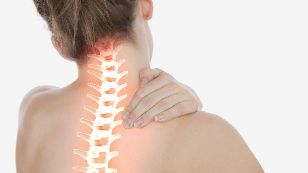
Cervical osteochondrosis - diseases of the cervical spine is accompanied by degenerative and dystrophic processes in intervertebral discs.
More than 80% of the population, who complain of pain in the neck. In addition, 30% of the users have a direct link with cervical osteochondrosis.
If this is a disease experienced the elderly, but more and more, and more and more are suffering from degenerative disc diseases of the neck of the 20 to 30-year-old patient.
For the reasons
Of the most unfavourable causes of the degeneration of the vertebrae of the neck are the following:
- the lack of movement, simply put, a lack of physical activity;
- irrational nutrition;
- prolonged physical activity;
- the salt of the petition;
- a variety of injuries;
- a violation of the metabolism and excess weight.
- prolonged sedentary work (e.g., a computer), without any interruption;
- improperly arranged a place to sleep (mattress, pillow);
- a long drive or a fixed drive.
Also, the risk factors are: hypothermia of the cervix, heredity, hormonal disorders.
In addition, in order to promote the development of degenerative changes in the cervical disc disease may be autoimmune diseases, such as rheumatism, systemic lupus erythematosus.
The disease develops slowly, but is prone to the advancement.
The symptoms of this
The key symptoms of degenerative disc disease of the neck:
- of the pain. This can be both a minor and a serious pain in the neck;
- stiff. This is usually in the range of the arm, shoulder, scapula, and neck, you may also feel a tingling sensation. The characteristic feature is the crunch of your neck while you turn your head;
- the noise and the ringing in my ears. Sometimes loss of hearing;
- migraines and headaches, muscle weakness in the arms or legs;
- weakness, shortness of breath. It seems that he is unable to breathe, which leads to oxygen starvation;
- blurred vision. Observed blurring of vision, decrease of visual acuity, there are the so-called "flies" before the eyes,
- the instability of the blood pressure. The patient, plagued by a high or low pressure, the result of which is a temple.
As for the pain, and it is most often followed by the patient turning the head or after sleep, minimal exercise, in your hand, coughing, or sneezing. The pain can be, so to speak, to "give" in the occipital region, shoulders, and arms. If you tilt your head forward, often has pain in the shoulder blade.
The diagnosis of
To make a diagnosis of cervical degenerative disc disease, you should consult with an orthopedist or a neurologist. He will conduct a review of the patient is sent for x-rays of the cervical, from several perspectives. In some cases, you may require a MRI scan, and an MRI the diagnosis.
The treatment of
Cervical osteochondrosis requires a long-term, systematic, and progressive treatments. Above all this therapy is designed to eliminate pain and combat inflammation.
In the early stages of the disease enough in manual therapy, therapeutic exercises. The more runs you a cure.
It is also important to create the conditions for the regeneration of the damaged tissue, but if you do, use products that have vitamin B in the form of injections or tablets.
It is necessary to take into account the regime of work and rest, to take care of a comfortable sleep, and not by the lifting of weights, and a way out of addiction.
Complications
Osteochondrosis of the cervical and many consider a rather insidious disease. After all of the cervical vertebrae, which are located close to each other, then at their minimum in the deformation of the compression of the nerve roots, and blood vessels. At the end of the, disorders of the blood, which leads to headaches, migraines. In more extreme cases, it is afflicted with ischemia or spinal cord, and even a stroke.
The danger is, and the cardiovascular system. Some of the people seen at the cardiologist because of the pain in his heart, continually "churning" the high pressure, and the reason lies in osteochondrosis of the neck.
Also, due to the compression of nerve endings, the patient may feel a sense of hearing, vision, disturbed coordination of movements.
In the advanced form, and without the proper treatment, the occurrence of hernia, treatment of, requiring surgical intervention.
In the elderly the cervical osteochondrosis is often in combination with deforming arthrosis of the cervical, the vertebral wear, etc
The prevention of
In order to avoid cervical degenerative disc disease, you need to lead a healthy lifestyle, eat healthy foods, performing regular exercise. A great role for the proper organisation of the workplace and the observance of the regime of work and rest.
































